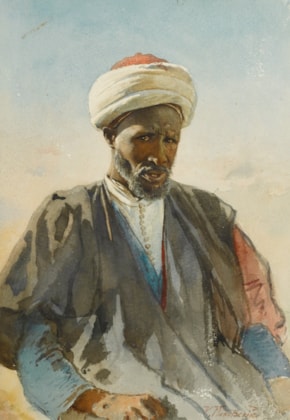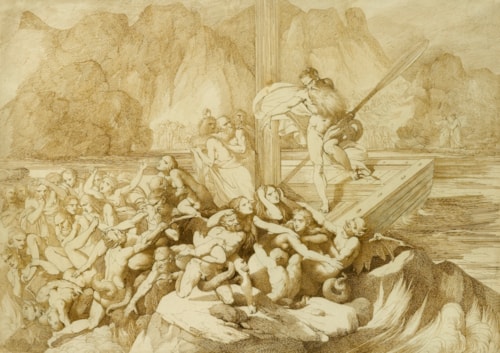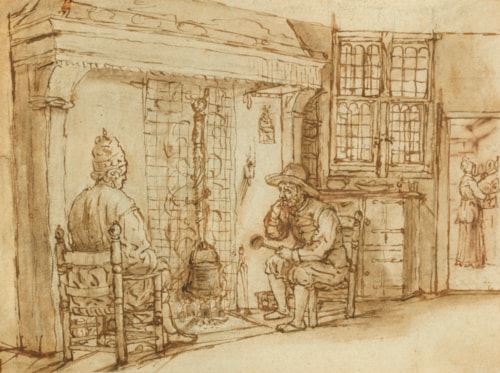iovanni David
(Gabella 1743 - Genoa 1790)
The Discovery of Romulus and Remus
bears partly erased old attribution: ‘Giovanni Battista Pittoni, Venezia 1687 - 1767’ (lower right of backing sheet)
pen and grey ink and brown and grey wash, over black chalk
32.2 x 45.4 cm (12⅝ x 17⅞ in)
The myth of Romulus and Remus and their subsequent foundation of Rome was of acute interest to Italian artists and their patrons. The scene captured in this exquisite drawing by Giovanni David focuses on the discovery of the twins by a shepherd. The sons of Rhea Silvia and Mars, the God of War, Romulus and Remus calmly suckle from the she-wolf that became irrevocably linked in legend to Rome’s origins.
The twins’ great-uncle, Amulius had dethroned their grandfather, Numitor, the rightful king of Alba Longa - which would become Rome. Fearing that his niece Rhea Silvia’s children could threaten this position, Amulius compelled her to become a Vestal Virgin and swear an eternal vow of chastity. The God Mars, however, is said to have seduced Rhea Silvia in a wood and by him she became pregnant with the twins. In fury, Amulius ordered that she be buried alive, following the conventional punishment meted out to Vestal Virgins for subverting her sacred oath, and that the twins be killed. The servant who was ordered to undertake this deed could not bring himself to kill such innocents and instead settled a basket with them inside onto the River Tiber. The river god, Tiberinus protected the twins and eventually set them down in the roots of a fig tree where a she-wolf, Lupus, nursed them. They were then discovered by a shepherd, Faustulus.
This tranquil scene radiates blissful solitude and displays a rare harmony between the natural world and its human inhabitants. The glassy river reflects the gently curving arches of a stone bridge as a shepherd quietly tends his flock by the water’s edge. An effeminate figure leans against the tree in the foreground. This pairing of two sinuous shapes underlines the intentional dominance of the figure as he stumbles upon the wolf suckling her human young. He holds his hand to his mouth in surprise and the incline of his head meets that of the startled wolf in a strong diagonal.
Classical subjects such as this one feature prominently in David’s work, although this sheet does not appear to be preparatory for a known painting or engraving. The myth of Perseus and Andromeda form the subject matter for one of his etchings and display the same carefully modelled characters. A 1775 etching also exploits the artistic potential of mythical subject matter with a rendition of Daedalus and Icarus. The highly finished style of The Discovery of Romulus and Remus perhaps places it in the later part of the artist’s career, being comparable as it is with a sheet depicting the Temptation of Saint Agnes in the Bibliothèque, Rouen which is preparatory for the painting of the same subject in the church of S. Maria del Carmine, Genoa, dating from circa 17891.
David worked extensively for Giacomo Durazzo (1717-1794) who had been the Venetian ambassador to Vienna. David’s main activity was in Genoa where he painted vast panoramic canvasses of battles in the 1780s. His work marked a sharp contrast to the academic tradition of Raphael Meng which was at that time prevalent in Liguria. David’s last period was devoted largely to the decoration of the church of S. Agnese, Genoa. This was characterized by a more dramatic and visionary style that is also evident in his drawings and engravings from those years including this present example.
1 Newcome, M. ‘Drawings by Giovanni David’ in Master Drawings, 1993, vol. 31, no. 4, p. 479, figs. 11-12 .
The myth of Romulus and Remus and their subsequent foundation of Rome was of acute interest to Italian artists and their patrons. The scene captured in this exquisite drawing by Giovanni David focuses on the discovery of the twins by a shepherd. The sons of Rhea Silvia and Mars, the God of War, Romulus and Remus calmly suckle from the she-wolf that became irrevocably linked in legend to Rome’s origins.
The twins’ great-uncle, Amulius had dethroned their grandfather, Numitor, the rightful king of Alba Longa - which would become Rome. Fearing that his niece Rhea Silvia’s children could threaten this position, Amulius compelled her to become a Vestal Virgin and swear an eternal vow of chastity. The God Mars, however, is said to have seduced Rhea Silvia in a wood and by him she became pregnant with the twins. In fury, Amulius ordered that she be buried alive, following the conventional punishment meted out to Vestal Virgins for subverting her sacred oath, and that the twins be killed. The servant who was ordered to undertake this deed could not bring himself to kill such innocents and instead settled a basket with them inside onto the River Tiber. The river god, Tiberinus protected the twins and eventually set them down in the roots of a fig tree where a she-wolf, Lupus, nursed them. They were then discovered by a shepherd, Faustulus.
This tranquil scene radiates blissful solitude and displays a rare harmony between the natural world and its human inhabitants. The glassy river reflects the gently curving arches of a stone bridge as a shepherd quietly tends his flock by the water’s edge. An effeminate figure leans against the tree in the foreground. This pairing of two sinuous shapes underlines the intentional dominance of the figure as he stumbles upon the wolf suckling her human young. He holds his hand to his mouth in surprise and the incline of his head meets that of the startled wolf in a strong diagonal.
Classical subjects such as this one feature prominently in David’s work, although this sheet does not appear to be preparatory for a known painting or engraving. The myth of Perseus and Andromeda form the subject matter for one of his etchings and display the same carefully modelled characters. A 1775 etching also exploits the artistic potential of mythical subject matter with a rendition of Daedalus and Icarus. The highly finished style of The Discovery of Romulus and Remus perhaps places it in the later part of the artist’s career, being comparable as it is with a sheet depicting the Temptation of Saint Agnes in the Bibliothèque, Rouen which is preparatory for the painting of the same subject in the church of S. Maria del Carmine, Genoa, dating from circa 17891.
David worked extensively for Giacomo Durazzo (1717-1794) who had been the Venetian ambassador to Vienna. David’s main activity was in Genoa where he painted vast panoramic canvasses of battles in the 1780s. His work marked a sharp contrast to the academic tradition of Raphael Meng which was at that time prevalent in Liguria. David’s last period was devoted largely to the decoration of the church of S. Agnese, Genoa. This was characterized by a more dramatic and visionary style that is also evident in his drawings and engravings from those years including this present example.
1 Newcome, M. ‘Drawings by Giovanni David’ in Master Drawings, 1993, vol. 31, no. 4, p. 479, figs. 11-12 .





 contact
contact contact
contact +44 20 7313 8040
+44 20 7313 8040









